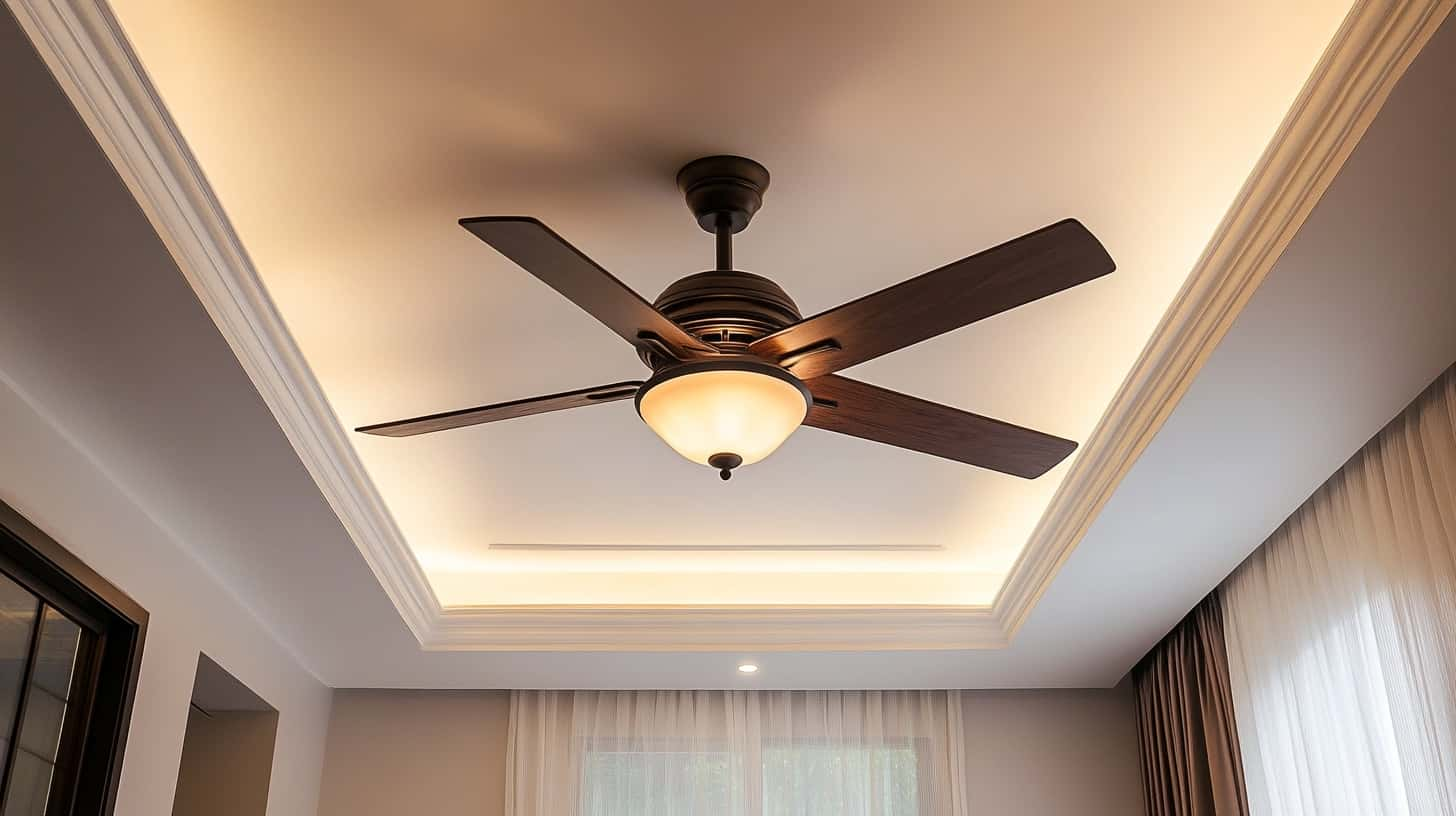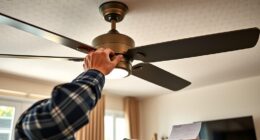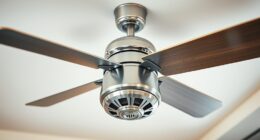Yes, you can and should lubricate your ceiling fan to keep it running smoothly and efficiently. Regular maintenance not only extends your fan's lifespan but also enhances its performance. Look out for signs like unusual noises or slow blade speeds, which indicate it may need oil. To lubricate, turn off the power and locate the oil hole, typically at the motor's top. Use non-detergent electric motor oil and follow the proper procedure to avoid issues. If you want to guarantee your fan's best performance, you'll find more helpful tips down the line.
Key Takeaways
- Yes, you can lubricate a ceiling fan to ensure smooth and efficient operation.
- Regular oiling extends the fan's lifespan and prevents overheating and motor burnout.
- Use non-detergent electric motor oil for lubrication, adding 1-2 ounces as needed.
- Always turn off power and use safety precautions before performing maintenance.
- If unusual noises persist after lubrication, seek professional help for further inspection.
Importance of Ceiling Fan Maintenance

Regular maintenance is vital for keeping your ceiling fan running smoothly and efficiently. One of the most important aspects of this maintenance is lubrication.
Regular oiling of ceiling fans extends their lifespan and guarantees peak performance by reducing friction and wear on the motor and bearings. Without proper lubrication, your fan could overheat or even suffer a motor burnout, leading to costly repairs or replacements.
It's recommended to perform maintenance, including lubrication, every 1-5 years, depending on how much you use your fan. If you notice any unusual noises, like grinding or squeaking, it's a clear sign that your fan needs oiling.
Addressing these issues promptly can prevent mechanical failures and potential safety hazards. Neglecting routine maintenance can turn minor problems into major headaches, making it essential to prioritize lubrication.
Signs Your Fan Needs Oil

If your ceiling fan starts making unusual grinding or squeaking noises, it's a clear sign it might need oil.
You should also pay attention if the blades aren't spinning as quickly as they used to, even on high speed.
Regularly checking the oil level can help you catch these issues before they lead to bigger problems.
Unusual Noises From Fan
Unusual noises from your ceiling fan are often a clear sign it needs oil. Sounds like grinding, squeaking, or a low hum indicate that the fan's motor or bearings require lubrication. If you ignore these noises, you might face increased wear and tear on the motor.
Regular maintenance is essential to keep your fan running smoothly and efficiently.
Here are some signs to listen for:
- Grinding: This may mean the bearings are dry and need oiling.
- Squeaking: A squeak often indicates friction, suggesting it's time for lubrication.
- Rattling: If you hear a rattle, check the oil levels; they might be low.
- Low hum: This can signal that the motor isn't getting enough lubrication.
To check for oil presence, use a pipe cleaner in the lubrication hole; if it comes out clean, it's time for oiling.
Many ceiling fans recommend checking oil levels every 1-5 years. Addressing these unusual noises promptly can prevent further damage and costly repairs, so don't wait!
Regular lubrication keeps your ceiling fan running smoothly for years to come.
Slow Spinning Speed
Noticing your ceiling fan's sluggish spin can be frustrating, especially when you expect it to circulate air efficiently. If your fan is spinning slowly, particularly on high speed, it's a strong indicator that it may need oiling. Insufficient lubrication can cause the motor to work harder, leading to wear and tear and ultimately shortening the fan's lifespan.
You should also pay attention if your ceiling fan is making noise. Grinding or squeaking sounds often mean the motor and bearings lack proper lubrication.
Regular maintenance is essential, and checking your fan's oil level every 1 to 5 years can help you catch these issues early. Oiling your fan not only restores its speed but also guarantees smoother operation and extends its life.
Ignoring the signs of a slow-spinning fan can lead to decreased performance and potential mechanical failure.
Oil Level Check
Regularly checking your ceiling fan's oil level is vital for guaranteeing ideal performance and longevity.
If you notice any of the following signs, it's time for an oil level check:
- Dry Pipe Cleaner: Insert a clean pipe cleaner into the oil hole. If it comes out dry, your fan requires oil.
- Grinding or Squeaking Noises: If your fan is making these sounds during operation, it's a clear indicator that it needs lubrication for smooth functioning.
- Slow Spinning: When the fan spins slowly, even on high speed, low oil levels may be the culprit. Replenishing the oil is essential for proper motor function.
- Oil Leakage: If you spot any oil leaking from the fan, check the oil reservoir immediately. This leakage can lead to performance issues if not addressed.
Performing routine maintenance, including these oil level checks every 1-5 years, will guarantee your ceiling fan operates efficiently and lasts longer. Additionally, keeping your fan well-oiled can significantly improve its overall performance and efficiency.
Don't overlook these signs; keeping your fan well-oiled is key to its best performance!
Tools Required for Oiling

To successfully lubricate your ceiling fan, you'll need a few essential tools. First, grab a step ladder to safely reach your fan. Once you're set up, you'll need a Philips-head screwdriver to remove the fan blades, allowing you access to the oil hole. Non-detergent electric motor oil is vital for ideal lubrication, so make sure you have the right type handy.
A pipe cleaner can be useful for checking oil levels and ensuring the oil hole is clear. If you notice any buildup or grime, a degreaser like WD-40 can help clean the oil hole before you add new oil. You might also need a wrench to loosen any screws or bolts that could be in the way.
Don't forget to keep paper towels or cloths nearby for cleanup; they'll help you wipe away any excess oil or dirt that accumulates during the process.
Finally, having your fan's user manual can provide helpful insights, confirming the correct oil type and detailing any specific maintenance instructions you should follow. With these tools at your fingertips, you're ready to get your ceiling fan running smoothly again.
Locating the Oil Hole

Typically, you'll find the oil hole on your ceiling fan located at the top of the motor near the downrod. It's often labeled for easy identification, making it simpler for you to locate the oil hole.
To guarantee your ceiling fan runs smoothly, it's vital to check your fan's oil regularly. Remember, a ceiling fan needs oiling if it shows signs of noise or reduced performance.
Here's how to locate and use the oil hole effectively:
- Use a Step Ladder: Safely position yourself to reach the fan.
- Power Off the Fan: Always switch off the ceiling fan before starting any maintenance.
- Identify the Oil Hole: Look for the labeled hole at the top of the motor.
- Insert a Pipe Cleaner: Use it to check your fan's oil levels; a clean pipe cleaner means oiling is needed.
If your fan doesn't have an oil hole, consult the manufacturer's manual. This might indicate a sealed motor design that doesn't require lubrication.
Regularly addressing these maintenance tasks can help keep your fan operating efficiently.
Checking Oil Levels

Checking the oil levels in your ceiling fan is essential for smooth and quiet operation.
You'll need a simple tool, like a bent pipe cleaner, to see if the oil level is adequate.
If your fan starts making unusual noises, it might be a sign that it's time to check and possibly add more oil.
Importance of Oil Levels
Maintaining proper oil levels in your ceiling fan is crucial to guarantee smooth operation and longevity. Low oil levels can lead to increased noise and reduced performance, causing unnecessary stress on the fan motor.
Regularly checking the oil level is essential, especially if your fan requires regular oiling. Here are some key points to take into account:
- Frequency: Check the oil levels every 1-5 years, depending on usage and manufacturer guidelines.
- Testing: Use a pipe cleaner with a ½-inch hook to test the oil level. If it comes out clean, your fan likely requires oil.
- Lubrication: Verify the oil reservoir is filled for proper lubrication; oil presence on the pipe cleaner after testing indicates it's time to refill.
- Sensitivity: Fans with built-in oil systems are particularly sensitive to oil levels. Neglecting maintenance can lead to motor damage and a considerably decreased lifespan.
Tools for Checking Oil
To guarantee your ceiling fan runs smoothly, using the right tools for checking oil levels is important. Start by locating the oil hole, usually found on top of the motor near the downrod. It's often labeled for easy identification.
Once you've found it, grab a pipe cleaner and bend one end into a small hook. This simple tool allows you to check the oil level effectively.
Insert the hooked end about half an inch into the oil hole. If it comes out clean, your fan requires lubrication. Regularly checking the oil level is recommended every 1-5 years, especially if you hear grinding noises from the fan, indicating it needs oil.
Remember to always turn off the fan before you check the oil level to ascertain your safety during this process.
For lubricating your ceiling fan, use non-detergent electric motor oil, with options like 10, 15, or 20 weight typically required. Keeping these tools handy and performing these checks will help maintain your fan's performance and extend its lifespan.
Signs of Low Oil
Noticing unusual sounds from your ceiling fan, like grinding or squeaking, often signals low oil levels that need your attention. If you're hearing these noises, it's time to check your fan's lubrication.
Here are some clear signs of low oil:
- Dry Pipe Cleaner: Inserting a clean pipe cleaner into the oil hole and pulling it out dry indicates your oil levels are low.
- Increased Noise: If your fan is making more noise than usual, it's a strong signal that it may need oiling.
- Slow Spinning: A ceiling fan that struggles to spin quickly can point to insufficient lubrication.
- Dirty Pipe Cleaner: If the pipe cleaner comes out dirty, it's time to clean and check your oil levels.
Regularly monitoring these signs is essential. Ideally, you should check your oil levels every 1-5 years, especially if your ceiling fan has a built-in oil system.
Neglecting lubrication can lead to performance issues, so keep an eye out for these indicators to guarantee your fan runs smoothly and efficiently.
Cleaning the Ceiling Fan

A clean ceiling fan is crucial for maximum performance and efficiency. Regular cleaning helps prevent dust and debris buildup, which can affect lubrication and the fan's overall performance. You should aim to wipe down the fan blades and housing at least once a month, or bi-monthly, using a microfiber cloth or paper towel with warm water and an all-purpose cleaner. This thorough cleaning guarantees that the oil level remains ideal and that all components function properly.
Before you start cleaning, always turn off the fan and let it dry completely before adding any oil. Mixing cleaning products with oil can lead to undesirable results.
To keep dust accumulation in check, consider dusting your ceiling fan weekly with a feather duster. This simple maintenance task can greatly reduce the need for deep cleaning and help maintain ideal airflow.
Oiling Procedure Steps

After confirming your ceiling fan is clean, it's time to focus on keeping it properly lubricated for peak performance. Proper oiling is essential for the fan motor's efficiency and longevity. Follow these steps for effective oiling:
- Turn Off Power: Use a step ladder to access the fan, confirming the power is turned off before starting any work.
- Locate Oil Hole: Find the oil hole typically on the top of the motor near the downrod. Clear any debris for easy access.
- Check Oil Level: Use a pipe cleaner bent into a hook to check the oil level. If it comes out clean, your ceiling fan needs oiling.
- Add Oil: Slowly pour 1 to 2 ounces of non-detergent electric motor oil into the oil hole, being careful not to overflow the reservoir.
After adding oil, manually spin the fan blades to help distribute the oil evenly throughout the motor. This step confirms that the oil reaches all necessary components.
Once done, turn the power back on and enjoy a smoothly running ceiling fan!
Safety Precautions

Before you start lubricating your ceiling fan, it's important to prioritize safety. First, always turn off the power to the ceiling fan at the circuit breaker. This step guarantees you're protected from electrical hazards while performing any maintenance. Make sure both the fan and its lights are switched off to avoid accidental activation during your work.
Next, use a sturdy step ladder to reach the fan safely. This helps you avoid any risk of falls as you access the oil hole. While you're at it, wear safety goggles to protect your eyes from potential oil splashes or debris that may occur during the lubrication process.
If at any point you feel unsure about electrical connections or maintenance procedures, don't hesitate to consult a professional. Their expertise can be invaluable in safeguarding your safety and preventing any mishaps.
When to Seek Professional Help

Even with thorough maintenance, some issues with your ceiling fan may signal the need for professional help. If you're facing persistent noise issues or other complications, it's vital to recognize when to consult an expert.
Here are four situations where seeking professional assistance is advisable:
- Persistent Noise: If oiling doesn't resolve grinding or squeaking sounds, it might indicate motor or wiring problems that require diagnosis and repair by a professional.
- Electrical Concerns: If you're uncomfortable handling electrical connections, it's best to call an expert to guarantee safety and proper maintenance.
- Inaccessible Lubrication Points: For fans lacking accessible oil holes, professionals can provide guidance or service to maintain efficient operation.
- Oil Leaks: If you notice oil leaks or excessive buildup, contacting an expert is necessary to prevent further damage and maintain your fan's integrity. Additionally, understanding content clustering can help you organize maintenance tasks more effectively over time.
Frequently Asked Questions
Can You Lubricate a Ceiling Fan Without Taking It Apart?
Yes, you can lubricate a ceiling fan without taking it apart.
Start by locating the oil hole, usually on top of the motor. Before you begin, make certain the fan is turned off for safety.
Use a pipe cleaner to check the oil level; if it's clean, add 1-2 ounces of non-detergent electric motor oil.
Let it settle to guarantee proper distribution before turning the fan back on for peak performance.
Can You Put WD-40 on a Ceiling Fan?
When it comes to putting WD-40 on a ceiling fan, you're barking up the wrong tree.
WD-40 isn't suitable for this purpose; it's not motor oil and can actually harm your fan's components.
Instead, you should use non-detergent electric motor oil designed specifically for ceiling fans. This guarantees smooth operation and extends the fan's lifespan.
If you can't access the oil hole, check the manufacturer's guidelines or call a professional for help.
What Oil to Use on a Ceiling Fan?
When you're looking for the right oil for your ceiling fan, opt for non-detergent electric motor oil designed specifically for fans.
Hunter high-grade SAE 10 oil is a great choice. Always check your fan's owner manual for the recommended oil weight, usually between 10 and 20.
Avoid using WD-40 or similar products, as they can pose fire hazards.
Regularly verify oil levels to keep your fan running smoothly and efficiently.
How Do You Fix a Noisy Ceiling Fan?
To fix a noisy ceiling fan, start by turning off the power for safety.
Check for loose screws or components and tighten them, as vibrations can cause noise.
If your fan has an oil hole, you might need to add 1-2 ounces of non-detergent electric motor oil.
After oiling, test the fan.
If it's still noisy, consider cleaning the blades or consulting a professional for deeper mechanical issues.
Conclusion
To sum up, giving your ceiling fan a little TLC with some lubrication can keep it spinning smoothly and extend its lifespan. If you notice any signs of distress, like unusual noises or a sluggish rotation, don't hesitate to roll up your sleeves and follow the steps outlined. But remember, if the task feels a bit overwhelming, it's perfectly okay to call in the pros for a little extra help. Your fan deserves the best care!









